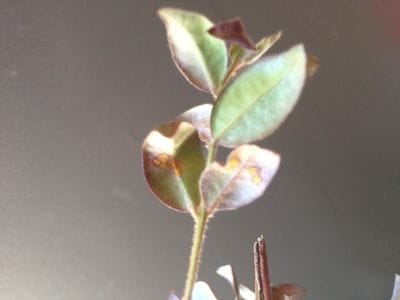DISEASES
Black Spot
Description

Control
Plant roses in a sunny spot with adequate air circulation to ensure the leaves are not continuously moist. Avoid overhead watering and water in the morning where possible. Remove any diseased leaves from the ground and avoid placing them in the compost to prevent further spread. Plants that are kept healthy will be less susceptible to black spot, so an adequate feeding and pruning program (see our fact sheet on pruning roses) will help to control disease in roses. Organic spraying can be carried out with a bicarb soda mix – 2 teaspoons to 5 litres of water mixed with a small amount of detergent. For non-organic control, sprays such as triforine or a rose gun can be used, as well as copper-based fungicides such as Kocide Blue.
Leaf Spot
Description
Leaf spot disease is caused by a variety of different fungi, although some leaf spots are also bacterial. It is usually host-specific and so will not spread from one plant species to another. Brown spots on the leaves are usually characteristic of leaf spot. A wide variety of plants are affected; some include iris, dahlia, eucalypts, grevilleas, bananas, strawberries and mulberry trees.
Control
Remove and destroy affected plant material, including any that has fallen onto the ground. Improving air circulation around the plant will help to control the disease. If infection is severe, spray with a fungicide such as copper oxychloride or mancozeb.
Powdery Mildew
Description
Powdery mildew is a fungal disease that attacks many different plants, including but not limited to, fruit trees such as apples, grapes, cucurbits such as pumpkins, zucchini and squash, and ornamentals such as roses and crepe myrtles. There are several different fungi which cause the disease, which is manifested by greyish white powdery spots on the leaves that eventually grow to cover the entire leaf surface. This can cause distortion of the leaf and/or leaf drop. Fruits, flowers and buds can also be affected. Powdery mildew is more common in damp, humid conditions where plants are crowded and air circulation is limited.
Control
Plant newer varieties that are less susceptible to powdery mildew and situate plants in well-ventilated, sunny spots where possible. If plants become infected, remove infected plant parts and prune to thin plants and create more air flow. A solution of 1 part milk to 5 parts water will help to control the disease. Fungicides such as wettable sulphur (not for cucurbits) and Mancozeb can also be used.
Sooty Mould
Description
Sooty mould is a fungal disease that appears as black, dry areas on the leaves of many plant species. This reduces the plant's ability to photosynthesise and affects the general appearance of the plant. Sooty mould is usually a secondary disease as it grows on the honeydew that is secreted by insects such as aphids and scale.
Control
Treating the underlying insect problem (see our 'Pests' fact sheet) and hence reducing the amount of honeydew on the leaves and stem of the plant will help to control the growth of sooty mould.
Brown Rot
Description
Brown rot is common in autumn and is the result of a fungus that lives in the soil. The fungal spores are splashed up onto the plant and cause a brown-coloured rot to develop at the base of citrus and stone fruits. The affected fruits will eventually drop. The disease can also affect the leaves and flowers as well as the fruit.
Control
Mulching around the base of the tree (ensure mulch is not touching trunk) will help to prevent spores from splashing up onto the tree. Remove and destroy any affected fruit. Spray with copper oxychloride in winter when the plant is dormant.
Root Rot
Description
Root rot is caused by fungi such as phytopthora and armillaria which infect the roots and stems of plants, causing rotting of the roots and eventually die back of leaves and branches. The disease eventually leads to death of the plant. The fungi favour poorly-drained conditions and spread via running water and contaminated soils. Phytopthora root rot is causing major losses to vegetation in many areas of Australia, including many national parks. It affects many trees and shrubs, including but not limited to, many eucalypts, proteas (and other plants of the Proteaceae family such as waratahs and banksias), strawberries, There's a wide variety of plants that are resistant – come in and see us for details.
Control
Remove and dispose of affected plants and replant the area with a resistant species. Improve drainage and avoid over-watering. Clean infected tools and boots. Mulching and improving the soil with organic matter such as compost and manure will help to encourage beneficial micro-organisms into the soil (just ensure that mulch does not touch the plant's stem). Sprays containing phosphoric acid, such as Rid a Rot and AntiRot can be used as a soil drench or applied directly on the plant's foliage.
Rust
Description
Rusts are caused by a range of different fungi and generally cause small yellowish spots to appear on the leaves of a wide variety of plants, such as wattle, iris, geraniums, roses, fruit trees and even turf. Fruits and flowers can also be affected. Recently myrtle rust has become a problem in plants of the Myrtaceae family, which includes lilly pillies, eucalypts and metrosideros.
Control
For small infestations, remove and dispose of affected leaves (do not compost). Keep plants healthy by choosing rust-resistant varieties that are suitable for the growing environment, and keep up appropriate watering and feeding regimes. Spraying is only necessary in severe cases, and can be carried out with a fungicide such as Mancozeb or copper oxychloride.



)
)





